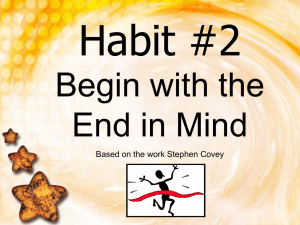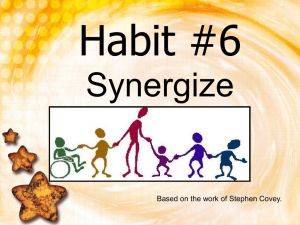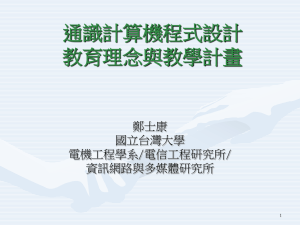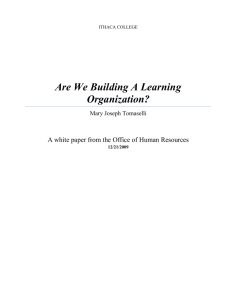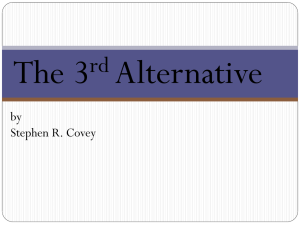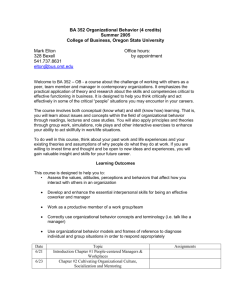ORGANIZATIONAL EFFECTIVENESS
advertisement
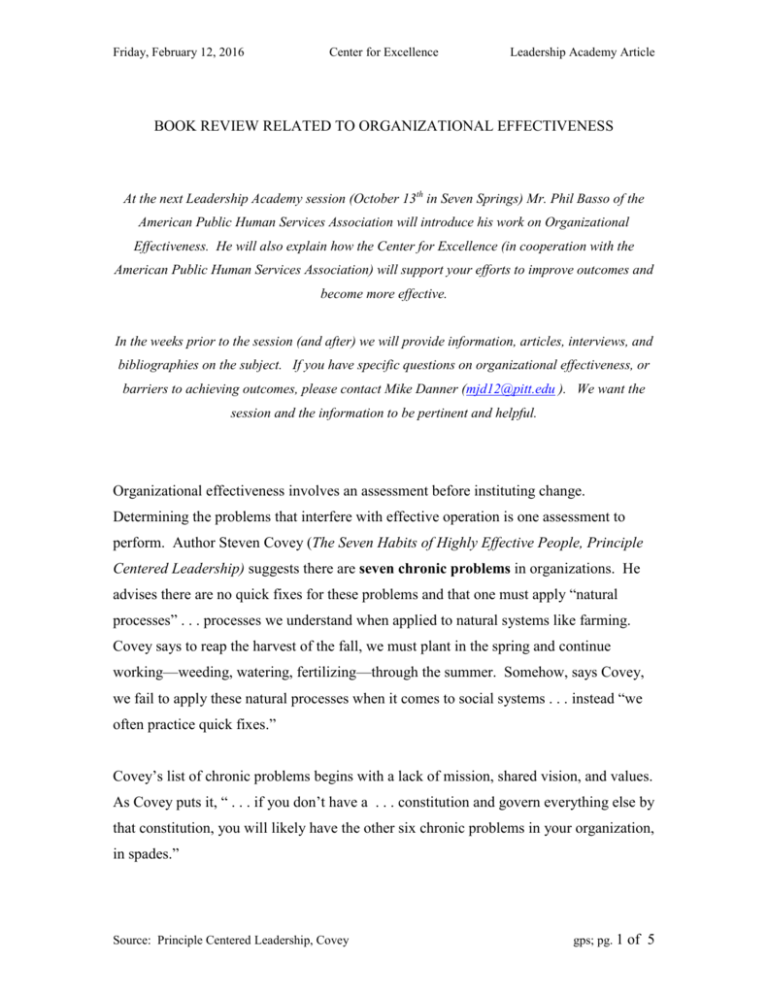
Friday, February 12, 2016 Center for Excellence Leadership Academy Article BOOK REVIEW RELATED TO ORGANIZATIONAL EFFECTIVENESS At the next Leadership Academy session (October 13th in Seven Springs) Mr. Phil Basso of the American Public Human Services Association will introduce his work on Organizational Effectiveness. He will also explain how the Center for Excellence (in cooperation with the American Public Human Services Association) will support your efforts to improve outcomes and become more effective. In the weeks prior to the session (and after) we will provide information, articles, interviews, and bibliographies on the subject. If you have specific questions on organizational effectiveness, or barriers to achieving outcomes, please contact Mike Danner (mjd12@pitt.edu ). We want the session and the information to be pertinent and helpful. Organizational effectiveness involves an assessment before instituting change. Determining the problems that interfere with effective operation is one assessment to perform. Author Steven Covey (The Seven Habits of Highly Effective People, Principle Centered Leadership) suggests there are seven chronic problems in organizations. He advises there are no quick fixes for these problems and that one must apply “natural processes” . . . processes we understand when applied to natural systems like farming. Covey says to reap the harvest of the fall, we must plant in the spring and continue working—weeding, watering, fertilizing—through the summer. Somehow, says Covey, we fail to apply these natural processes when it comes to social systems . . . instead “we often practice quick fixes.” Covey’s list of chronic problems begins with a lack of mission, shared vision, and values. As Covey puts it, “ . . . if you don’t have a . . . constitution and govern everything else by that constitution, you will likely have the other six chronic problems in your organization, in spades.” Source: Principle Centered Leadership, Covey gps; pg. 1 of 5 Friday, February 12, 2016 Center for Excellence Leadership Academy Article As you work to improve outcomes and provide the best services for your families, do any of these problems hamper your ability to do so? Problem 1—no shared vision and values: either the organization has no mission statement or there is no deep understanding of and commitment to the mission at all levels of the organization. Resolving this problem often requires more than an administrator realizes, says Covey. In most cases, organizations have a mission statement but it’s not part of the culture because people did not have a part in creating it. (Check your Supervisory CORE training notes—Managing Results, where mission statements were discussed.) Problem 2—no strategic path: either the strategy is not well developed or it ineffectively expresses the mission statement and/or fails to meet the wants and needs and realities of the stream. Covey explains that strategic thinking has changed from a “roadmap” to a “compass” perspective. The reason being the “stream” (environment) is so unpredictable that a map is of little value. People in the organization need compasses fixed on the “true north” of mission, vision, and values so they can react to the ever changing environment. He goes on to explain that the mission and the stream are both important and must be considered in any strategic planning effort. Problem 3—Poor alignment: bad alignment between structure and shared values, between vision and systems; the structure and systems of the organization poorly serve and reinforce the strategic paths. Covey recommends you ask yourself if every person who comes to the organization is committed to the constitution (mission, values, vision) . . . and does every system and process reflect the constitution? If not, he suggests that you have an alignment problem. Source: Principle Centered Leadership, Covey gps; pg. 2 of 5 Friday, February 12, 2016 Center for Excellence Leadership Academy Article Problem 4—Wrong style: The management philosophy is either incongruent with the shared vision and values or the style inconsistently embodies the vision and values of the mission statement. Covey mentions that you may have to adapt your style to match the vision and the values of the organization. He attributes this “need to adapt” to the great amount of diversity and mobility in our society and our workplaces. The old management styles may no longer reflect the mission, vision, and values of the organization . . . . (Ref: Supervisory CORE Training; Situational Leadership, and DiSC /The Platinum Rule) Problem 5—Poor skills: style does not match skills, or managers lack the skills they need to use an appropriate style. As Covey says, “Even if they have the desire, motivation, and physical ability, they still need improved skills to negotiate effectively.” He states further, “Their style and skills may be suited to only one kind of . . . terrain or weather condition . . . .” This problem is easily resolved with training and education. (Here’s an opportunity to develop your leadership team in conjunction with the training program. Contact the program for help in developing your team.) Problem 6—Low Trust: staff has low trust, a depleted emotional bank account, and that low trust results in closed communication, little problem-solving and poor cooperation and teamwork. Covey describes this problem as a “chicken or the egg” dilemma, advising that if you attempt to work on the trust issues without working on the other problems you will only exacerbate the situation. He defines trust as “the quality of the relationship between people” and suggests the best way to build trust is to work on the mission statement and alignment issues. (those of you who had the section on Core Variables in your supervisory training will recall being instructed to look close to the center (mission, goal and sometimes structures) when encountering problems with climate/morale, the external Source: Principle Centered Leadership, Covey gps; pg. 3 of 5 Friday, February 12, 2016 Center for Excellence Leadership Academy Article environment, and sometimes the structures themselves.) He cautions against keeping a closed management style when initiating your mission and alignment efforts since people won’t trust your words or motives if you’ve not changed your approach. Covey feels that trust is more than integrity; “it also connotes competence.” He gives the example of an honest doctor . . . a doctor who must also be competent if you are going to trust her or him. Problem 7—No integrity: values do not equal habits; there is no correlation between what I value and believe and what I do. When Covey detects one of the seven chronic problems in an organization where managers blame everyone or everything else, he suggests they look in the mirror and ask themselves only one question, “Do I have integrity?” In other words, have I acted in ways that demonstrate my values . . . in ways that demonstrate commitment to the mission . . . in ways that build the emotional bank account . . . ? Have I adapted my style to the rigors and demands of the new stream? How would you rate your organization? Covey’s Problem Not a problem Needs work Major Overhaul No shared vision and values No strategic path Poor Alignment Wrong (management) style Poor Skills Low Trust No integrity Source: Principle Centered Leadership, Covey gps; pg. 4 of 5 Friday, February 12, 2016 Center for Excellence Leadership Academy Article If you were to “map” each problem area in a force field analysis format, how would it look? (Place each on a line that indicates it’s a driving force (positive) or a restraining force (problem). Remember: the line length signifies the relative strength of each item.) DRIVING FORCE RESTRAINING FORCE With force field analysis, you’ll recall that you attack the strongest restraining force (problem) first, while continuing to reinforce the driving forces (strengths). But, as Covey told us, if Problem 1 is not resolved, then you will have the others in spades! Do you have a mission statement and declaration of values that “fits” your community, is clear, people agree with it, and are committed to it . . . ? If not, that should be your starting point. What is your strongest restraining force? What are two strategies you might use to weaken or eliminate this restraining force? Where might you use consultants or technical assistance to resolve the problem (s) Source: Principle Centered Leadership, Covey gps; pg. 5 of 5
